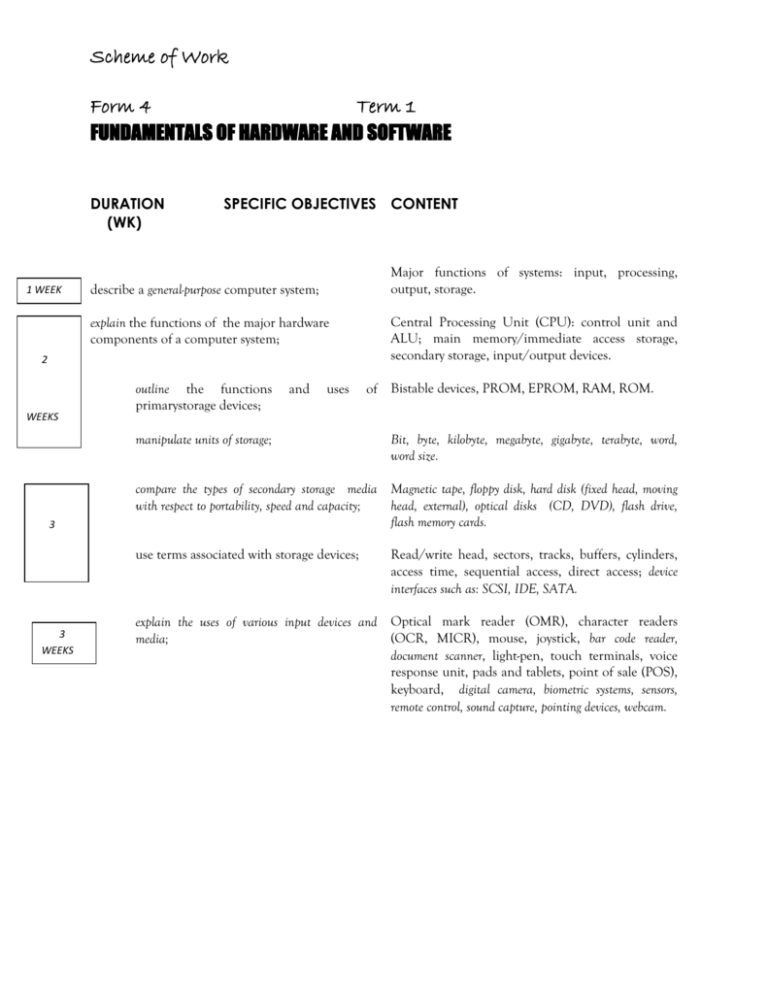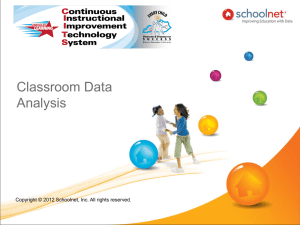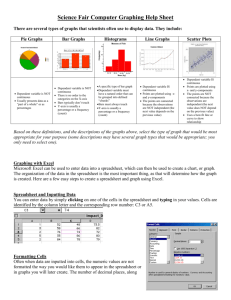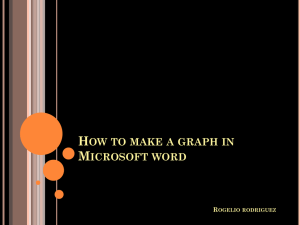IT Scheme of Work (Forms 4 & 5)
advertisement

Scheme of Work Form 4 Term 1 FUNDAMENTALS OF HARDWARE AND SOFTWARE DURATION (WK) 1 WEEK SPECIFIC OBJECTIVES CONTENT Major functions of systems: input, processing, output, storage. describe a general-purpose computer system; explain the functions of the major hardware components of a computer system; 2 WEEKS outline the functions primarystorage devices; and uses manipulate units of storage; 3 3 WEEKS of Bistable devices, PROM, EPROM, RAM, ROM. Bit, byte, kilobyte, megabyte, gigabyte, terabyte, word, word size. compare the types of secondary storage media Magnetic tape, floppy disk, hard disk (fixed head, moving with respect to portability, speed and capacity; head, external), optical disks (CD, DVD), flash drive, flash memory cards. use terms associated with storage devices; WEEKS Central Processing Unit (CPU): control unit and ALU; main memory/immediate access storage, secondary storage, input/output devices. Read/write head, sectors, tracks, buffers, cylinders, access time, sequential access, direct access; device interfaces such as: SCSI, IDE, SATA. explain the uses of various input devices and Optical mark reader (OMR), character readers (OCR, MICR), mouse, joystick, bar code reader, media; document scanner, light-pen, touch terminals, voice response unit, pads and tablets, point of sale (POS), keyboard, digital camera, biometric systems, sensors, remote control, sound capture, pointing devices, webcam. FUNDAMENTALS OF HARDWARE AND SOFTWARE (cont’d) DURATION SPECIFIC OBJECTIVES CONTENT (WK) 2 WEEKS state the types and functions of output devices; describe how data are stored manipulated within the computer; 2 Visual display unit: resolution, types, sizes. Printers: impact and non-impact, types: (character, line, page, laser, inkjet, dot matrix).Characteristics: (speed, quality, storage capacity); plotters; audio output devices (for example, speakers, head-phones, earphones); microfilm. Also terms such as hard copy, soft copy, human readable and machine–readable. and Binary, octal and hexadecimal number systems; binary addition and subtraction. Integers (positive and negative): sign and magnitude, BCD, two’s complement; representation of characters, ASCII. WEEKS interpret the hardware specifications of a CPU type and speed; memory: capacity, type, word size, computer system; speed. Hard drive: capacity, speed; fire wire, expansion slots, ports. Scheme of Work Form 4 1 WEEK 2 Term 2 distinguish between systems programs and Systems software: operating systems, translators, utilities: application programs; Application software: general purpose, special purpose, custom written. Customization, integrated software. explain the functions of an operating system; File management, memory management, security, device management, input/output management, user interface, process management. Distinguish among multitasking, multiprocessing and multiprogramming; Basic treatment of these terms. (See glossary). explain the different types of processing modes; Batch processing, real-time, on-line, time-sharing. Distinguish between types of user interface. Software interface: Command driven, graphical user interface (GUI) (menu driven, pull-down and pop-up menus, icons). Hardware interface: touch screens, nonvisual interface, sensors, and Braille keyboards. WEEKS INTERNET AND COMMUNICATIONS TECHNOLOGY DURATION (wk) 1 1. 2. WEEK 1 3. WEEK SPECIFIC OBJECTIVES CONTENT distinguish among Internet, intranet and Refer to glossary. extranet; explain concepts Internet; associated with the Including Electronic mail (e-mail), newsgroups, Internet Relay Chat (IRC), Telnet, File Transfer Protocol (FTP), upload, download, World Wide Web (WWW), web browser, HTTP, Hypertext Markup Language (HTML/XHTML), web page, website, blogging, webserver, URL, e-commerce, elearning, HTTP, pod-casting, bulletin board, VoIP. describe measures to secure data and Software Restrictions: passwords, encryption, virus protection, maintain data integrity; firewall; physical access restrictions: biometric systems, guards, locks; fire/water proof cabinets; archiving; backup and recovery procedures; propriety data and software. Scheme of Work Form 4 Term 2 (continued) APPLICATIONS AND IMPLICATIONS OF INFORMATION AND COMMUNICATIONS TECHNOLOGY (cont’d) SPECIFIC OBJECTIVES 1 WEEK 1 WEEK 4. outline ways by which information can be Violation of privacy, propaganda, software piracy, computer misused; fraud, electronic eavesdropping, industrial espionage, surveillance, storage of inaccurate information, identity theft, credit card fraud. 5. describe appropriate hardware and Projects to determine the relevant hardware and software (open software to meet the particular needs of source vs. proprietary) used in areas including business, a given application; industry, science and technology, education, law enforcement, recreation, music, gaming. 6. Describe current technological trends; 7. assess the impact of Information Computer skills used by office employees, teachers, engineers, medical personnel, musicians, mass media Technology on job skills and careers; personnel, law enforcement personnel, movie industry; loss of jobs; retraining; telecommuting. 8. Describe the roles of various personnel The functions of individuals in computer-related fields: in computer-related professions. programmers, systems analysts and designers, IT managers, systems programmers, database administrators, network administrators, IT managers, file librarians, computer technicians, computer engineers, software engineers, software testers, webmaster, web-developer, software trainer, multi-media artists. 1 WEEK CONTENT and emerging Expert systems, robots, CADD, CAE, CAM, telemarketing, teleconferencing. Scheme of Work Form 4 Term 2 (continued) SECTION 5: INFORMATION PROCESSING SPECIFIC OBJECTIVES 1 1. 2. WEEK 1 3. 4. WEEK 2 5. distinguish information; between data CONTENT and Data as raw unprocessed facts; information as processed data. explain the characteristics and Forms of Information Processing: automation, process functions of Information Processing; control, commercial, industrial, and scientific data processing; information retrieval and management. identify the sources of data in Source document, turnaround document, machine and specified application areas; human readable document. describe methods of validation and Difference between validation and verification. Methods: verification of data; range check, reasonableness checks, data type checks, inconsistency checks. identify appropriate verification and Such as double entry to identify validation checks given a particular typographical/transposition errors. scenario; and correct WEEKS 6. describe various methods of file Sequential field ordering; random, index-sequential; directorganization and access; access, sequential-access. 7. select appropriate file organization for Associate an appropriate file structure and access method to a particular application. specific application. For example, a payroll file would be organized sequentially with sequential access. Scheme of Work Form 4 Term 3 PROBLEM-SOLVING AND PROGRAM DESIGN GENERAL OBJECTIVE On completion of this Section, students should have an understanding of the fundamental principles and practices of problem-solving on the computer. DURATIONSPECIFIC OBJECTIVES (WK) CONTENT outline the steps in problem-solving; 1 WEEK 1 WEEK Definition ofthe problem; propose and evaluate solutions; determination of the most efficient solution; develop and represent algorithm; test and validate the solution. decompose a simple problem into its The components are: input; process; storage; output. significant parts; distinguish between variables and constants; Variables as an area of storage whose value can change during processing; the value of a constant never changes. use appropriate data types; Integers, floating point (real), characters, literals. explain the concept of algorithms; Definition of algorithms; Characteristics: finite number of steps, precise, unambiguous, flow of control from one process to another, terminate. identify ways of representing algorithms; Representation of algorithms as Pseudocode or Flowcharts; Use of flowchart symbols: input/output, process, decision, directional arrows. Pseudocode - Use of: Read, Input, Store Write, Output, Display, If-then; If-then-else; For loop; while loop; (questions which require nested conditionals or nested loops will not be asked). 2 WEEKS Truth Tables Use of relational operators: <, >, =, <=, > =, <>. Logical operators: AND, OR, NOT. Arithmetic operators: +‚ –‚ *, /. Simple problems including; average, maximum. 2 WEEKS develop algorithms to solve problems; simple Use ofproblem-solving techniques outlined in Specific Objective 1 to the solution of simple problems. PROBLEM-SOLVING AND PROGRAM DESIGN (cont’d) 1 WEEK SPECIFIC OBJECTIVES CONTENT test algorithms for correctness; Construction and use of trace tables to determine result. Trace table consists of variable names (identifiers) as column headings and values in the cells, one row for each pass. use the top-down design approach to Application of stepwise refinement to problems with two or more problem solving. tasks. 1 WEEK Scheme of Work Form 4 SPECIFIC OBJECTIVES Term 3 (Continued) CONTENT Students should be able to: 1. 1 WEEK distinguish between low-level and high- Low-level language (Machine or Assembly Language); High-level level programming languages; language (Pascal, C). 2. distinguish among the different Characterization of first through to fifth generation languages. generations of programming languages; 3. list the sequence of steps associated with Create source code, compile, linking, executing, maintain implementing a program; program. 4. explain commonly used terms and Testing, debugging, syntax errors, logic errors, run-time errors, dry concepts in programming; run, test data. 1 WEEK 5. declare elementary data types; Integers, real numbers, characters. 6. declare variables and constants; Use of meaningful variable names and constants; assign initial values. 7. manipulate data; Reading from and writing to variables, arithmetic operations. use control structures; Conditional branching: if-then, if-then-else, Loops: while, repeat, for. manipulate data in a list; Declare 1-dimensional arrays; reading from and writing to arrays; traversing arrays; linear search. 1 WEEK 8. 9. 1 WEEK 10. 11. perform checks and tests programs to verify correctness; Write documented programs. on Testing and debugging techniques. Importance of documentation; features of internal documentation (use of mnemonic names, use of comments, indentation, effective use of white spaces); external documentation (user manuals). Scheme of Work Form 5 Term 1 WORDPROCESSING GENERAL OBJECTIVE DURATION SPECIFIC OBJECTIVES CONTENT (WK) select appropriate editing features in the Deleting and inserting characters, words, lines, sentences, preparation of a document; paragraphs. Type-over mode. Selecting blocks of text. Copying and moving sections of text. describe commonly available features; Page numbers, page breaks, text alignment, wordwrap, margins, tabs, page length, default settings, font size. select appropriate formatting features for the Margins, tab stops, line spacing, page breaks, page numbers, left and right justification, centre line, preparation of a document; underline, highlight, uppercase, bold, and italic. 2 WEEKS use headers, footers, footnotes and endnotes appropriately; combine documents; perform block operations; use columns and tables appropriately; apply appropriate character formatting Underline, bold, italics, font types and sizes, superscript and subscript. features; 3 use search appropriately; and WEEKS use mail-merge facilities; 1 WEEK replace functions Creation of primary documents and data files in mail merge application; Field names. use spell-check; import documents; Text files, graphics, tables including options such as automatic save and backup copy, password protection, track changes. WORDPROCESSING &PRESENTATION (cont’d) B: PRESENTATION DURATION SPECIFIC OBJECTIVES CONTENT (WK) 1 WEEK 2 WEEKS explain the uses of presentation software; explain the concepts of wizards, templates and slides; choose appropriate slide layout; Slide layout must relate to the type of information being presented. apply design templates to slides; Choosing from a list of presentation designs. use formatting features effectively to enhance Changing background colour, font size and other attributes, presentation; such as font colour and bullets. create slide headers and footers; 2 For example, to enhance public speaking; to deliver lectures; to present project reports; to effectively present sales or marketing ideas. Use of the slide master to personalize the slides. create and use speaker notes; WEEKS 3 WEEKS apply various types of animation effects to Flying, drive-in, camera effects; flash-once, typewriter; laser, slides; reverse-texts, drop-in effects. Custom animation; timing and sound effects. insert graphics and moving pictures into a slide; manipulate multiple slides; Insertion and deletionof slides; use of the slide sorter. presenta slide show. Use of slide show tools such as slide navigator, pointer options, screen attributes. WEB PAGE DESIGN Form 5 Term 2 DURATION SPECIFIC OBJECTIVES CONTENT (WK) 2 1. WEEKS 2. 2 3. 4. WEEKS create a simple web page; Choosing an appropriate design for a page; inserting and deleting text and graphics; wrap text with image; create thumbnail image, index page, home page, hyperlink. create hyperlinks; Linking to another web page; link to a location within the web page; link to an email address; link to user-created files. test the website; Use of a web browser; verify that all the hyperlinks work correctly; use a test audience. publish and maintain a website. Registering domain names; locate hosting company; the use of the file transfer protocol (FTP) for uploading files. SPREADSHEETS DURATION (WK) 1 1. SPECIFIC OBJECTIVES explain the purpose of a spreadsheet; WEEK 1 2. WEEK 3. 1 4. 5. WEEK CONTENT Definition of spreadsheet: a spreadsheet is a table consisting of cells (rows, column locations) that hold accounting or financial data and simulates the traditional physical spreadsheet; it captures displays and manipulates data. use appropriate terminology and notions Row, column, cell, cell address, label, value, formula, function, commonly associated with spreadsheets; worksheet, template, range, title, window, record. select basic pre-defined systems functions; Including sum, average, date, maximum, minimum, count, if, vlookup, rank. create advanced arithmetic formulae; Formulae involving addition, subtraction; multiplication; division; powers; square roots, the use of brackets. explain the use of common features of Row/column title locking, relative addressing, absolute spreadsheet software; addressing. invoke row and column title locking; Horizontal, vertical, both. replicate (copy) formulae into other cells; Relative versus absolute addressing. manipulate data on a spreadsheet; Effects of move, copy, delete operations on formulae. manipulate columns and rows; Insert and delete columns and rows. format a spreadsheet; Numeric data formatting, text formatting, alignment, borders. sort a spreadsheet; Primary field, secondary field, ascending vs. descending order. find a record matching a given criterion; Simple criterion, complex criterion, record - find command. 13. perform charting operations; Bar charts, line graphs, pie charts, graph titles, labels on axes. 14. select appropriate graphical representation of data; 15. manipulate multiple worksheets; Use of two or more worksheets to solve problems involving some or all of the functions and operations listed above. import files. Graphics, tables. 1 6. 7. WEEK 8. 1 9. 10. WEEK 11. 1 12. WEEK 1 WEEK16. DATABASE DURATION SPECIFIC OBJECTIVES CONTENT (WK) 1 1. explain the concept of a database; Definition of database: repository of information; collection of tables that are related to each other. use terminology commonly associated with a database; Database terminology: table (relation), entity, tuple, attribute, primary key, secondary key, composite key, candidate key, alternate key, foreign key. 3. distinguish among terminology associated with files and databases; Row (tuple, record), column (attribute, field), key. Data types: alphanumeric; numeric; data; logical. 4. outline the advantages and limitations of Comparison with files with regards to: Speed; Ad hoc queries; databases; standardization; present multiple views of the same data. 5. create a database; Table structure with at least three data types and populate with at least twenty-five records. Use of wizard is prohibited. modify a table structure; Adding new fields, deleting fields, changing field definitions. sort a database; Arranging data in numeric, alphabetic; or alphanumeric format. Report generating facilities of the database package, including use of sorting, grouping statistical and summary features, for example, count, sum and average. 8. establish relationships; Use of joins, merge tables/files. 9. query a database using multiple search Using more than one criterion; use of select, calculated fields. conditions; 10. determine the results of a search on a Two or more fields involving the use of relational and database given multiple conditions; logical operators. 11. generate reports to the screen, printer and Report generating facilities of the database package, including files. use of sorting, grouping, statistical and summary features, for example, count, sum and average. 2. WEEK 1 WEEK 6. 1 7. WEEK 1 WEEK






